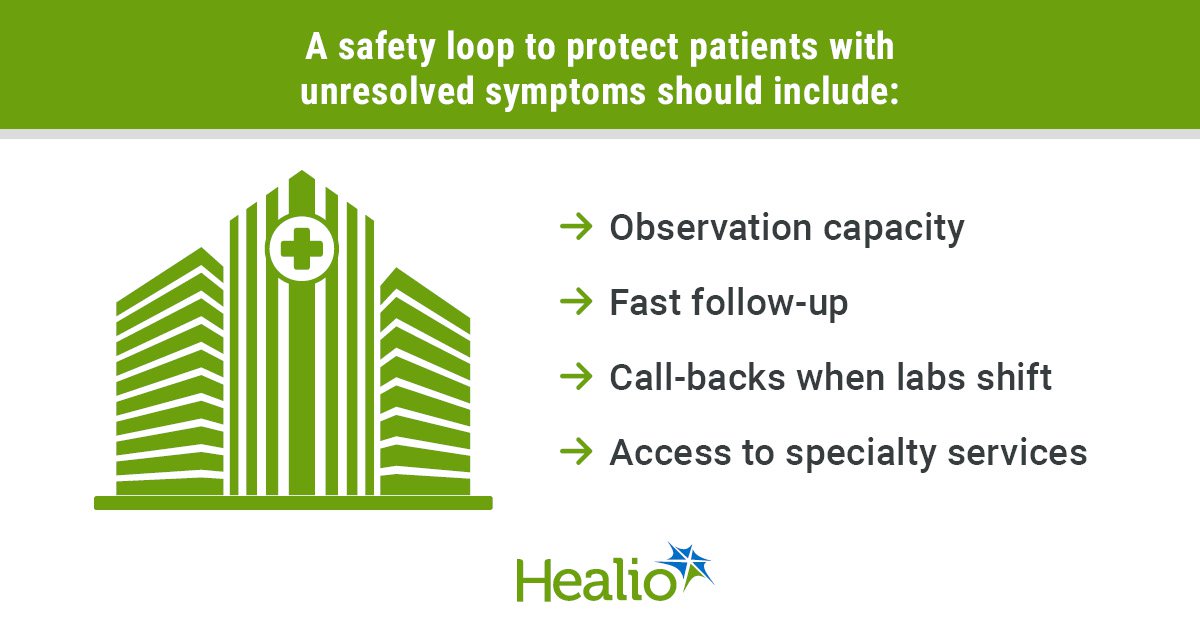November 06, 2025
5 min read
Key takeaways:
- Overcrowded EDs, vexing EHRs and limited staff threaten patient safety.
- Health systems must improve observation capacity so clinicians do not need to make admit-or-discharge choices in the face of uncertainty.
Every emergency medicine physician has a case that lingers long after the shift ends — the patient who appeared stable, said they felt “a little better,” but ultimately wasn’t OK.
We carry those cases with us long after the shift ends. Usually, the reminders are secondhand in the form of a colleague mentioning a patient we discharged who returned with a new diagnosis or was admitted. We shake our heads, replay the encounter and move on a little heavier.

But sometimes, the story ends much differently. For example, in the rare, devastating cases like Sam Terblanche, a young patient evaluated for nonspecific and vague viral-type symptoms multiple times in the same ER and discharged home with instructions to “return if worse,” who then painfully passed away. This possibility is every ED doctor’s deepest fear that haunts us and leads to a sense of despair and indescribable pain, not only for us but clearly for his family and close friends.
Stories like Sam’s hit us hard. The grief is real, and so is the fear that, in today’s EDs, uncertainty can easily become extraordinary harm.
The impossible math
EDs were built to resuscitate and stabilize, but they now serve as overflow wards for admitted patients who wait hours on gurneys, as primary care hubs for patients without them, and as after-hours urgent care for everything else. When hallways become inpatient units, the bandwidth for the “looks OK but might not be” patient shrinks.
In recent years, it has unfortunately become common practice to evaluate patients sitting in chairs instead of on stretchers, a far cry from the conditions ideal for a thorough physical exam. What began before COVID-19 but intensified during the pandemic has lingered as staff shortages persist and patient volumes grow. Many EDs never fully regained the space, the staffing or the breathing room that pandemic-era strain took away. The result is a constant sense of triage, not just of patients, but of attention itself. There is always one more person waiting, one more alarm sounding, and never quite enough room to pause and look twice.

Owais Durrani
At its core, emergency medicine is about ruling out what’s life-threatening, not confirming what’s elusive. The ED is built for immediacy, for stopping strokes, stabilizing trauma, catching heart attacks in progress. But in that design lies an uncomfortable truth — many conditions don’t reveal themselves in a single visit, and some don’t declare their danger until much later. The balance we strive for, ruling out emergencies, observing when the picture is unclear and acknowledging that the ED isn’t meant to provide every answer has become harder to maintain in an environment that rewards speed over reflection.
Systems shape thinking
Electronic health records were meant to help us document, but too often, they relegate us to an endless series of “clicks” that lead to alarm fatigue and blindly accepted alerts. Could AI-embedded algorithms within such a framework have made a difference in Sam’s case? Maybe they could have triggered longer and more complex differentials that not only suggested more nuanced thinking and actions but mandated additional consultations — and, more importantly, a strong recommendation for an observation stay or hospital admission.

Robert Glatter
Unresolved symptoms that can’t be explained in the face of abnormal vital signs should serve as a warning that discharge and “return if worse” are not medically sound options. That said, closer monitoring of patients by senior residents and attending physicians is an essential part of sound medical care. While AI is evolving and does exhibit potential to help guide decision-making, we must remain vigilant for complex patients who could be discharged prematurely and at high risk for adverse outcomes.
Uncertainty deserves a safety net
“It’s a virus” is often shorthand for “we don’t yet have a single unifying answer.” That isn’t indifference — it’s honesty about medicine’s limits of an initial visit. But such “honesty” only protects patients if the system provides a safety loop: observation capacity, fast follow-up, call-backs when labs shift and access to specialty services. Too often those supports don’t exist. Patients are told to “return if worse” into the same crowded bottleneck that missed the “early signal” — generalized, broad and nonspecific symptoms that could represent a benign viral illness or something much more deadly — to begin with.
And if patients are unable to advocate for themselves or arrange proper follow-up after a visit for a vague set of symptoms with a potentially problematic outcome, the responsibility rests with us to develop a system that can “close the loop” and safely secure follow-up in a timely fashion.
The lack or absence of such a follow-up process is a sign of our inability to properly monitor and manage patients who leave our care without a structured plan or health care provider to conduct a reevaluation of their symptoms and determine next steps in their care. We must prioritize the important role of observation beds for those with vague or nebulous diagnoses that may place patients at risk for subsequent harms. Not doing so reduces our ability to capture patients whose disease process is evolving or unclear whose discharge may place them at risk for complications or even death.
With recent cuts to Medicaid, and the looming expiration of ACA subsidies leading to increased premiums for patients seeking care in emergent situations, the reality of achieving a robust safety net are tenuous at best. The recent closure of a critical access hospital in California, exposing the economic reality of implementing such safety measures for our most vulnerable patients on a large scale, serves as an example of how political decisions collide with and undermine efforts to protect and safeguard patients who live in health care deserts.
Improving patient safety in the ER starts with system design, not heroics. Boarding metrics should be tracked and reported like infection rates. Observation units and next-day follow-up options must expand so uncertainty doesn’t force an admit-or-discharge choice. Electronic records need fewer pop-ups and more purpose, and staffing should match the reality of today’s volume so clinicians have time to think. AI tools can serve as an added checkpoint, flagging mismatched symptoms or labs that deserve a second look before discharge. We cannot promise perfection, but we can build for it.
If we want fewer stories like Sam’s, we must stop demanding flawless outcomes from flawed systems and start designing emergency care that gives vigilance, curiosity and compassion room to breathe.
For more information:
Owais Durrani, DO, an emergency medicine physician with the Memorial Hermann Health System, can be reached at owaisdurrani@gmail.com; Instagram @acedurrani; LinkedIn https://www.linkedin.com/in/owaisdurrani/; X @owaisdurrani; and YouTube @drowaisdurrani.
Robert Glatter, MD, an assistant professor at the Zucker School of Medicine at Hofstra/Northwell and emergency medicine physician at Lenox Hill Hospital, can be reached at rglatter@northwell.edu; Instagram rdglatter; LinkedIn https://www.linkedin.com/in/dr911/; and X @DrRobertGlatter.











